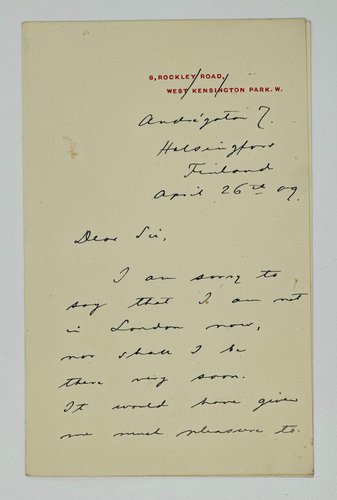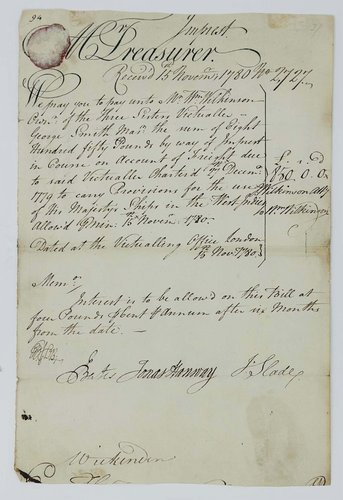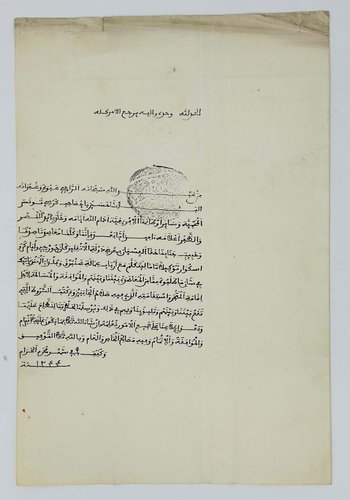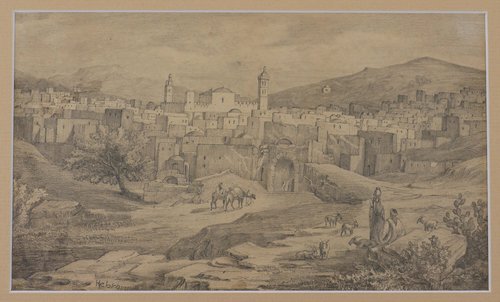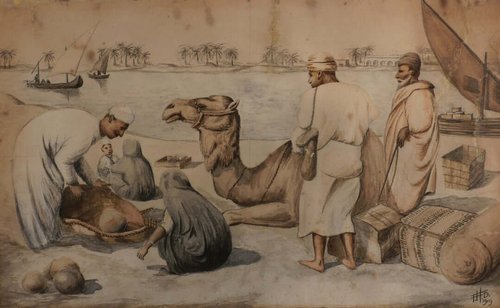










































#PC57
Ca. 1890s.
Folio (ca. 28,5x39,5 cm or 11 ¼ x 15 ½ in). 28 card stock leaves. With 65 mounted albumen photos, including 47 large images from ca. 24x30 cm (9 ½ x 11 ¾ in) to ca. 20x26 cm (7 ¾ x 10 in) and 18 smaller photos ca. 10x14,5 cm (4 x 5 ½ in) or slightly smaller. Most smaller photos are numbered in negative; five are also captioned and signed “G. Berggren” in negative. Twenty-six large photos are captioned and signed in negative: twenty-one by “G. Berggren,” four by “Abdullah Frères” and one by “Sebah & Joailler.”. Period brown half morocco album with cloth boards; spine with raised bands; gilt-lettered title “Turquie” on brown labels mounted on the front board and the spine; marbled endpapers. Binding slightly rubbed on extremities and worn on hinges, mounts slightly waved and age-toned, but overall a very good album of strong interesting photos.
Attractive collection of large panoramic and close-up views of Istanbul and its environs, as well as portraits of Turkish people taken by noted local studios of Guillaume Berggren, Abdullah Frères and Jean-Pascal Sebah (1872-1947) and Polycarpe Joailler (1848-1904).
The album opens with eighteen smaller portraits (mostly by G. Berggren), showing Turkish elders, women, a water seller, a porter, a cook, a Persian merchant, a Montenegrin, and an Orthodox Greek priest. The large photos include excellent views of Sultan Ahmed (Blue) Mosque, Dolmabahce Palace (entrance gate), Beyazit Square, Topkapi Palace (an entrance in the inner courtyard), the Fountain of Sultan Ahmed III, Hagia Sophia (general view, the entrance gate), Taksim Military Barracks, Mihrisan Valide Sultan Fountain, Beylerbeyi Palace, Galata Tower, the Serpent Column, ruins of the Palace of the Porphyrogenitus, the Walls of Istanbul, Lykos/Bayrampasa Valley, the Aqueduct of Valens, Bayezid II Mosque, Turkish cemetery, elaborate marble arabesques decorating buildings, general views of the Istanbul Historical Peninsula, Galata and the Golden Horn, &c. There are also lively scenes and portraits with Turkish cobblers, street barbers and their clients, men smoking hookah, women from a harem on a countryside outing, porters, shoemakers, &c. Overall a nice collection of large well-preserved photos of Istanbul and its people in the late 19th century.
A list of captions: Marchand Pérsan. No. 14. G. Berggren; Porteur d’Eau. Kurd. No. 10. G. Berggren; Montenegren. No. 32. G. Berggren; Dame Turque. No. 5. G. Berggren; Hamal Turc. No. 25. G. Berggren; Les Chiens errants de Const.ple. Abdullah Frères. 216; Savetiers Turcs. Abdullah Frères; Barbiers ambulants. Abdullah Frères. 322; 295. Café turc. Sebah & Joailler; Mosquée du Sultan Mehmed. No. 150. G. Berggren; Porte de Dolma-Bugtché Côté Quest. No. 100. G. Berggren; Place de Séraskierat. No. 138. G. Berggren; Porte du Hirka-i-Cherif au Vieux Serail. No. 114. G. Berggren; Fontaine d’Achmed. No. 12. G. Berggren; Porte de la Ste. Sophie. No. 124. G. Berggren; No. 85. Caserne d’Artillerie à Taxim. G. Berggren; No. 9. Kiosk et Fontaine des Eaux Douces d’Asie. No. 159. G. Berggren; Palais de Beylerbey. G. Berggren; No. 84. La Tour de Galata. G. Berggren; No. 2 Cimetiére Turc. G. Berggren; La Colonne Serpentine sur la Place de l’Hyppodrome. No. 87. G. Berggren; Vue intérieure du Château de Belisair (Tekir Serail). No. 127. G. Berggren; Piedestal de l’Obelisque de Théodose. No. 89. G. Berggren; Vue extérieur du Murs de Constantinople. No. 126. G. Berggren; Vallée de Lycos. 173. G. Berggren; Vue gégérale de l’Aquédut de Valens. No. 149. G. Berggren; No. 94. Vue de Foundoukli et Dalma-Bagtche. G. Berggren; Ste. Sophie. No. 11. G. Berggren; Mosquée du Sultan Achmed. No. 86. G. Berggren; Mosquée du Sultan Bayazid. No. 139. G. Berggren; No. 8. Pont de Karakeuy. G. Berggren; Cordonniers Turcs. Abdullah Frères. 306.
Guillaum (Pehr Vilhelm) Berggren was a Swedish photographer who opened a studio in Constantinople in the late 1860s. “Berggren was quite a typical photographer of his time, taking many standard tourist views but also displaying good panoramas and photographing local types in the studio and on the street. He took some photographs in other countries but most of his work was in Turkey, including a number of views of Anatolia. In his advertisements, he boasted of being photographer to the Kings of Sweden and Norway. In 1895, he transferred his portrait business to former assistant, David Joseph, but continued to sell and publish views. In 1900, he had a shop at 9 Asmali Medjid which specialized in the sale of Turkish views. Berggren studio was still open in the early 20th century, but in 1916 he sold part of his archive to the German Embassy in Istanbul” (Jacobson, K. Odalisques & Arabesques: Orientalist Photography, 1839-1925. Quaritch, 2007, p. 215).
“Abdullah Frères, three Ottoman Armenian brothers Vichen (1820-1902), Hovsep (1830-1908) and Kevork Abdullah (1839-1918) who ran a profitable studio in Constantinople with other locations in Cairo and Izmir. In 1862 the three brothers were named official royal photographers to the courts of the Sultans Abdul Aziz and Abdul Hamid II, and had the right to use the royal monogram. While official royal photographers to the Sultans they were commissioned to document the Ottoman Empire in photographs. The work appears to have been conceived by the sultan as a portrait of his empire for the 1893 World Columbian Exposition but was not exhibited there. It dwells on the accomplishments and westernizing improvements of the regime, such as the well drilled and equipped military, the technologically advanced lifesaving and fire fighting brigades, customs bureaucracy, and life at the lavish Imperial court.” (Lusadaran: Armenian Photography Foundation).
“Constantinople-based photographic studio Sebah & Joaillier formed from a partnership between Joannes (Jean) Pascal Sebah and Policarpe Joaillier which dates only from 1890, but from its establishment, took over the marketing of the catalogue of fine images produced in Turkey and Egypt by [Jean’s father] Pascal Sebah. Sebah operated a studio in Constantinople from the 1860s, and also worked in Egypt from 1873. The same images, therefore, have been marketed by the studio at various times as being the work of P. Sebah, J.P. Sebah, or Sebah & Joaillier. Following Pascal Sebah’s death in 1886, the Turkish studio was operated by his brother Cosimi for a time, who also trained Pascal’s son in the art of photography. Joannes, known as Jean, reputedly joined the business aged 16, took it over at aged 18, and immediately entered into a partnership with Policarpe Joaillier. Joaillier returned to France in 1910, but with subsequent partners, Jean Sebah remained actively involved with the studio until 1943. From the 1870s, Sebah, and later Sebah and Joaillier, were major subjects of evocative imagery to the increasing number of people to undertook the Victorian Grand Tour. Their studio images of Egyptians and Nubians in “traditional” costumes and undertaking “traditional” tasks were highly popular, and indeed had been Pascal Sebah’s Les Costumes Popularies de la Turquie published to critical acclaim in 1873” (Hannavy, J., ed. Encyclopedia of Nineteenth-Century Photography. Vol. 1, New York, 2008, p. 1261).











































